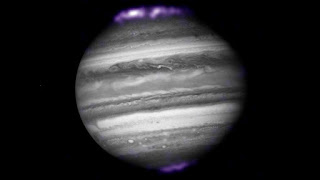In a collaboration by planetary astronomers, measurements from NASA's Juno spacecraft in Jupiter's orbit and data from ESA's Earth-orbiting XMM-Newton mission were used to unravel a four-decade mystery of Jupiter's unique X-ray auroras. For the first time, the entire process has been observed. The ions causing the X-rays are seen "riding" electromagnetic waves in Jupiter's magnetic field, plunging into the planet's atmosphere. The study was published in the Science Advances journal on July 9, 2021.
Auroras have been spotted on seven planets within our solar system, some visible to the naked eye and others only detectable through specialized telescopes. Jupiter's auroras are the most powerful within the solar system due to the energy required to produce shorter wavelengths of light.
Since the discovery of Jupiter’s X-ray auroral emission forty years ago, scientists have been intrigued. It was unclear how the energy needed to generate it was produced. These Jovian northern and southern lights are known to be triggered by ions colliding with Jupiter's atmosphere. However, the method through which ions reach the atmosphere to cause the X-ray light show was unknown till now.
On Earth, auroras are typically only visible in a belt surrounding the magnetic poles, between 65 and 80 degrees latitude. Beyond 80 degrees, auroral emission disappears since the magnetic field lines exit Earth and connect to the magnetic field in the solar wind. Jupiter’s X-ray auroras, however, are distinct. They exist poleward of the main auroral belt, pulsate, and often differ between the north and south poles, indicating a closed magnetic field.
Researchers used computer simulations to propose that the pulsating X-ray auroras might be linked to closed magnetic fields originating within Jupiter and stretching millions of miles into space before looping back. To validate this model, they referred to data from both Juno and XMM-Newton from July 16 to 17, 2017. Jupiter's X-ray aurora was seen pulsating every 27 minutes during XMM-Newton's 26-hour observation period.
Simultaneously, Juno was traversing the region above Jupiter's pre-dawn area, the area simulations suggested was critical for triggering the pulsations. The researchers found that Jupiter’s magnetic field fluctuations caused the pulsating X-ray auroras. The outer boundary of the magnetic field is struck directly by solar wind particles and compressed, heating ions trapped in Jupiter's extensive magnetic field, far away from the planet's atmosphere. This triggers electromagnetic ion cyclotron (EMIC) waves, directing the particles along the field lines. The ions ride the EMIC wave across millions of miles of space, eventually colliding with the planet’s atmosphere and triggering the X-ray auroras.
“What we see in the Juno data is this beautiful chain of events. We see the compression happen, we see the EMIC wave triggered, we see the ions, and then we see a pulse of ions traveling along the field line,” said William Dunn of the Mullard Space Science Laboratory, University College London, and a co-author of the paper. “Then, a few minutes later, XMM sees a burst of X-rays.”
Now that the missing piece of the process has been identified for the first time, it opens up a wealth of possibilities for where it could be studied next. For example, at Jupiter, the magnetic field is filled with sulfur and oxygen ions being emitted by the volcanoes on the moon Io. At Saturn, the moon Enceladus jets water into space, filling Saturn’s magnetic field with water group ions.
Reference: “Revealing the source of Jupiter’s x-ray auroral flares” by Zhonghua Yao, William R. Dunn, Emma E. Woodfield, George Clark, Barry H. Mauk, Robert W. Ebert, Denis Grodent, Bertrand Bonfond, Dongxiao Pan, I. Jonathan Rae, Binbin Ni, Ruilong Guo, Graziella Branduardi-Raymont, Affelia D. Wibisono, Pedro Rodriguez, Stavros Kotsiaros, Jan-Uwe Ness, Frederic Allegrini, William S. Kurth, G. Randall Gladstone, Ralph Kraft, Ali H. Sulaiman, Harry Manners, Ravindra T. Desai and Scott J. Bolton, 9 July 2021, Science Advances.
DOI: 10.1126/sciadv.abf0851

Post a Comment